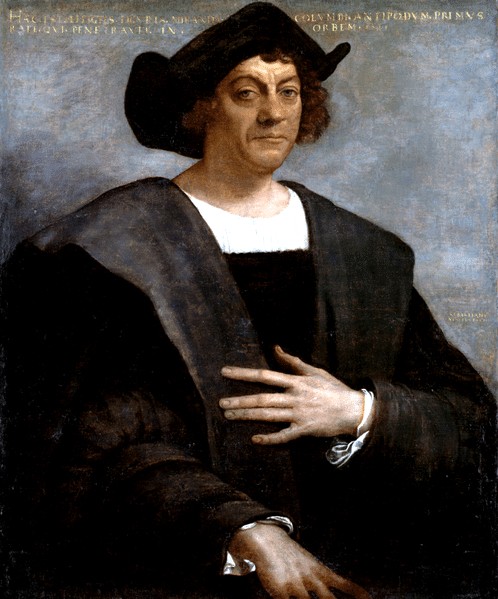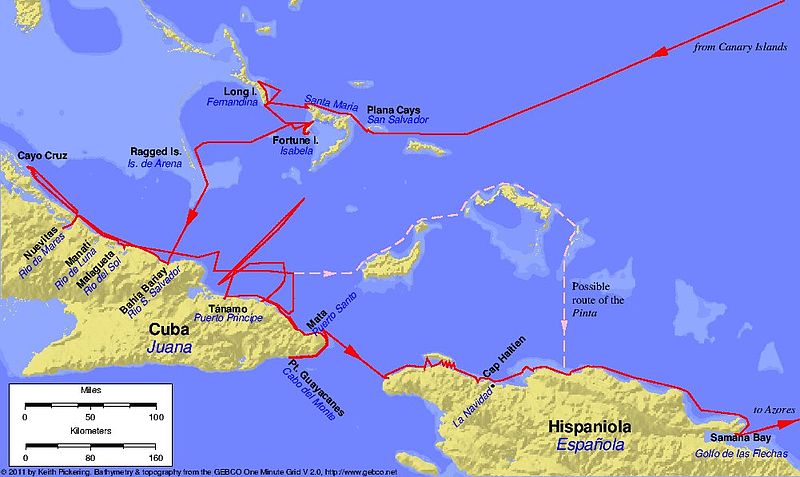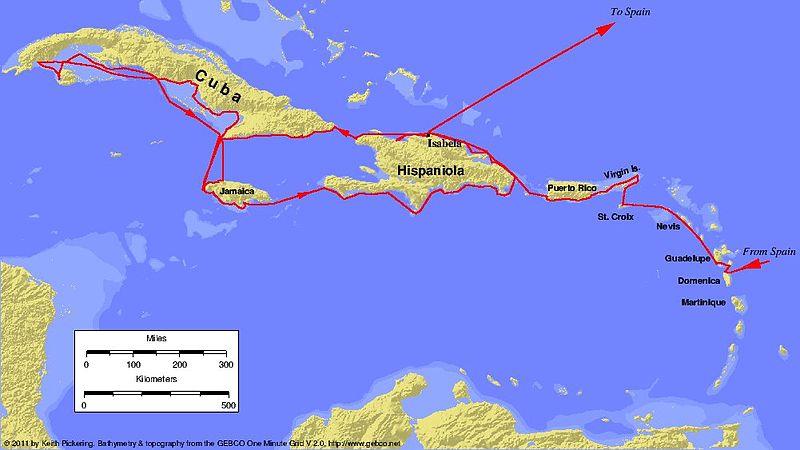Christopher Columbus was born to his father, Domenico Colombo, and mother, Susanna Fontanarossa. There are many interesting Christopher Columbus facts about his family.

His father was a weaver in Genoa and then owned a tavern when they moved to Savona. He was obviously a resourceful man and had a good business head because he owned each of those businesses at a time when it was hard to do so.
Jump to:
Domenico and Susanna had three other children outside of the infamous Christopher Columbus: Bartolomeo, Giovanni Pellegrino, and Giacomo, all of whom were brothers.
Christopher's brother Bartolomeo was a successful weaver in Lisbon for a portion of his life.
Early Life and Accomplishments

Christopher Columbus began his navigation career at the age of 10. This resulted in him gaining experience at a young age.
Due to his taking to the sea at such an early age, Columbus never knew how to write in his native language.
In 1470, Columbus' parents and the family moved to Savona, where his dad began a tavern. This was also the year that Columbus and others attempted an attack on the Kingdom of Naples.
In 1473, Columbus began an apprenticeship with some of the most influential families in Genoa. During this time, he made trips to England, Ireland, and possibly Iceland.
In 1479, he married Filipa Moniz Perestrelo, who was the daughter of a Portuguese governor and nobleman. A year later, his first son, Diego Columbus, was born.
In 1485, Filipa either died or Columbus left her for 20-year-old-orphan Beatriz Enriquez de Arana. It is certain that he found a mistress in Spain in 1485 if Filipa had not died. However, there is no more information about her.
Between 1482 and 1485, Columbus gained more knowledge of the ocean when he traded around the coast of Africa. He sailed as far as Guinea.
Throughout his life, Columbus was an ambitious learner. He was fluent in Latin, Castilian, and Portuguese.
He also studied astronomy, navigation, geography, and history, which included The Travels of Marco Polo, The Travels of Sir John Mandeville, and The Works of Ptolemy. Each of these works was influential in his life.
Columbus was a self-educated man who developed deep convictions during this time. Some of these convictions were wrong, and some would be earth-changing. Columbus was an avid reader of the Bible and especially biblical prophecy. At the end of his life, he authored a Book of Prophecies in which he interpreted his career as an explorer as part of biblical prophecy.
Plans to Sail to Asia
During the Mongolian Empire, Europe enjoyed a time referred to as Pax Mongolica. There was peace throughout Europe and Asia, and passage on the so-called "Silk Road" was easy and profitable.
After the fall of Constantinople to the Ottoman Turks, the road became much tougher. This resulted in Europeans trying to find alternate ways to India and China.
Portugal believed that they could sail around Africa and reach India and China. This belief was furthered when Bartolomeu Dias sailed around the Cape of Good Hope in 1488. During this time, Christopher and his brother began to believe there was another way to reach the Indies.
A popular myth that surrounds Columbus is that people would not fund his trip due to the belief that the earth was flat. This false information comes from Washington Irving's writings in which he said that Columbus had trouble with funds because the Catholic church insisted that the earth was flat.
This was not the case, and the book A Voyage Long and Strange: On the Trail of Vikings, Conquistadors, Lost Colonists, and Other Adventurers in Early America point out that it was believed that the earth was spherical as far back as the ancient Greeks with Aristotle.
Columbus' difference was not that he believed the Earth was a sphere, and everyone else believed it was square. Columbus believed that he could reach the Indies based on three misconceptions.
- His gross miscalculation of the size of the earth
- His high estimate of the size of Asia
- His belief was that Japan and other inhabited islands were far to the east of China.
All three of these convictions were wrong and against the belief of most scholars that day. This is why he had a hard time receiving funding and not because the earth was flat.
Although Columbus was wrong in his calculations, he was an exceptional navigator and perhaps the best navigator in history. He knew the trade winds of the Atlantic and how to navigate them. This would be one of the reasons he was successful.
Columbus traveled to Europe in search of someone who would sponsor his voyage. He visited King John II in Portugal but was rejected because they believed his calculations to be wrong. He then visited King Henry VII, who considered it, and eventually decided to send Columbus. However, his decision was too late because Spain had decided to sponsor his trip.
Ferdinand II of Aragon and Isabella I Castile had been approached by Columbus in 1486. They denied his request, but Columbus continued to lobby for their support. In 1492, Columbus finally won their support after their important victory in Granada, which was the last Muslim stronghold.
First Voyage

Columbus set sail for the Indies from a port in Palos de la Frontera on August 3, 1492, in his three ships: Nina, Pinta, and Santa Maria.
The lookout on the Pinta, Rodrigo de Triana, spotted land at 2 am on October 12. He would have been given a lifetime pension from Ferdinand if Columbus had not claimed that for himself by undermining Rodrigo when he returned to Spain by saying he saw the land two hours earlier.
Columbus landed on what is now the Bahamas. He called it San Salvador, although the locals called it Guanahani.
The natives here had many scars, and when Columbus asked where they came from, they told him that a tribe from another island had come to conquer them and take them away.
Columbus thought that they would make excellent servants and could easily be converted to Christianity, so he took 6 of them to Europe with him.
On October 28, 1492, Columbus explored the coast of Cuba. Here, the Santa Maria ran aground and had to be abandoned. Columbus was received by the natives who lived in Cuba, who gave him permission to leave 39 of his men behind to build a settlement.
He encountered his only resistance in what is now known as the Dominican Republic. He returned home on March 15, 1493. His first voyage was complete. News of his discoveries spread quickly throughout Europe.
Other Voyages

Columbus's second voyage was much more sophisticated. Rather than 3 ships, he had 17 and 1,500 people to colonize the Indies with. He set sail for the Indies with his large caravan on September 24, 1493. During this voyage, he took a more northerly route. Along the way, he found and named many new islands.
- Montserrat
- Antigua
- Redonda
- Nevis
- Saint Kitts
- St. Eustachius
- Saba
- Saint Martin
- Saint Croix
- Virgin Islands
He then sailed onto Hispaniola, where he planted a small colony of 39 men in 1492. He returned and saw it in ruins. It had been destroyed by the Taino people.
What Columbus did afterward is not confirmed. Perhaps he was brutal to the natives, or he took a more diplomatic approach. Whatever he did is not documented and is speculation. There are not many primary sources that still exist during this time period.
After Hispaniola, he explored the coast of Cuba. After his exploration of Cuba, he returned to Spain on August 20, 1494.
Afterward, Columbus sailed on two more voyages and had little success.
Later Life and Death
Christopher Columbus demanded that the Spanish Crown give him 10% of all profits made in the New World.
The crown reneged on their original offer in the Capitulation of Sante Fe as they did not feel obligated to oblige to his commands after he was relieved of his governorship.
Columbus died on May 20, 1506, at around the age of 54, of a heart attack. He died believing that he had reached Asia.
